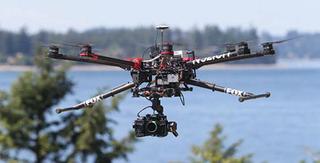What Broadcasters Need to Know About Using Drones
Drones have become powerful tools for broadcast media, providing a safer and more cost-effective alternative to helicopters for gathering aerial footage and covering rapidly unfolding events. Whether it’s flying above the landscape of Texas after catastrophic floods, or recording a new perspective on architecture and infrastructure, drones are a reliable, efficient way for journalists to tell visual, data-informed stories. As The New York Times outlined in “5 Times Drones Told the Story,” drones have changed journalism by putting the aerial perspective in the hands of reporters.

The advantages of drones are obvious – they allow news crews to reach locations that would be hazardous or inaccessible to conventional ground transport or aviation, at a lower cost, and with a smaller footprint. But before media organizations implement a drone program in the U.S., they should understand Part 107, the FAA rules and regulations for commercial drones. Here are some of the most important things broadcasters need to know about using drones.
WHO SHOULD OPERATE DRONES?
Consider structuring your drone operations in a team—a drone operator, journalist and observer. Working together makes it easier to ensure that the drone flight is compliant with the rules and regulations of Part 107 and increases the quality of the news footage captured.
●The operator must obtain a Part 107 remote pilot certificate. Because the operator is responsible if there is an accident, they must be the final decision maker to ensure the flight is safe and legal.
●The journalist can contribute ideas to ensure the operator captures the desired images. They should be onsite to gain their own perspective of the situation; however, it’s important to create a detailed flight plan, including hazards and points of interest before takeoff so the flight team is on the same page and non-safety-related communication is minimized during flight.
●The observer aids the operator with safety and situational awareness. The observer should keep the pilot informed of any potential hazards and keep pedestrians from wandering into the flight area or distracting the pilot.
Get the TV Tech Newsletter
The professional video industry's #1 source for news, trends and product and tech information. Sign up below.
WHEN CAN DRONES BE FLOWN?
Per Part 107, drones can be flown under 400 feet, and at or below 100 mph, in Class G airspace, with three miles of visibility, and during daylight hours. Drones are not permitted to fly above people who are not part of the operation without a waiver from the FAA.
Planning flights using Skyward or another validated drone airspace map is the best way to ensure that compliance with Part 107 requirements and leveraging the benefits drones bring to the news organization.
WHERE ARE DRONES PROHIBITED?
Part 107 prohibits drones from being flown in a variety of situations, including at night, near airports or wildfires, and above people who aren’t part of the operation. In the news industry, the images that can best bring the story to life are often within those restricted areas.
If the ideal flight plan is in controlled airspace, a regulatory waiver might allow the drone to fly, if the flight isn’t increasing risk to people or property on the ground or in the air. Approved waivers can last for up to 24 months, so a single waiver could greatly aid operations. However, the application process takes up to 90 days to process, so applying for waivers before they are needed is a good practice. The FAA’s new Low Altitude Authorization and Notification Capability (LAANC) system, due to go live in February 2018, will give operators faster, easier access to some controlled airspace areas. Operators will be able to request access to LAANC airspace from the Skyward map.
Though Part 107 specifies that drones cannot directly fly above any person not participating in an operation, it doesn’t stipulate a minimum distance. These tips can help broadcasters obtain relevant images and remain compliant to Part 107:
●When a large group of people gather, a drone is an ideal tool to capture the size of a crowd and get the widest possible view. The best bet is to use side angles to get lateral shots of crowds. Take off and land at an adjacent location for a horizontal view of the crowd.
●Get permission to take off or land on private property. To avoid conflicts, contact the property owners in advance to request permission to use their land. Be sure to obtain their agreement in writing.
●Beware when flying in major cities. Airspace in major media hubs, such as New York City and Washington, D.C., is heavily controlled to protect busy airports and airstrips—airspace is often protected within a five-mile radius of an air traffic control tower. An airspace authorization waiver from the FAA can provide access to controlled airspace. Check flight plans against an airspace map, such as Skyward, to ensure the flight is within allowed airspace.
COMPLYING WITH PART 107
Traditional aviators rely on a series of checklists, including pre-flight, in-flight, post-flight, and emergency checklists, to mitigate risk and stay in compliance with regulations. Develop a strong general operating manual that establishes all the safety procedures and operational practices required for every drone flight, including a comprehensive set of checklists.
Even though every newsroom is different and every news story requires a unique flight, knowing the requirements of Part 107 and understanding how to remain compliant can help ensure media drone programs don’t end up on the wrong side of the news.
Eric T. Ringer is senior product manager & co-founder at Skyward.
